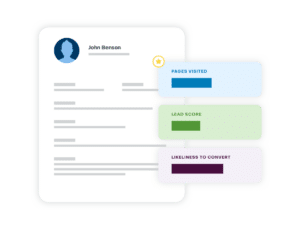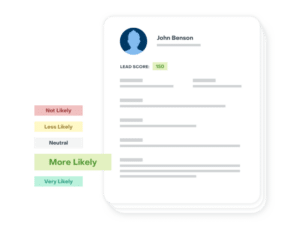Optimize Your Website for the New Buyer Journey
Consumers love to buy, but they hate to be sold. They ignore preprocessed marketing messages that don’t speak to their immediate interest. This raises a new challenge to marketers—when and how do they reach out to prospects with an authentic message to influence their buying decisions?
Marketers have addressed these issues with marketing automation, which enables them to market on multiple channels online (email, social media, websites, etc.) more effectively.
Having an online presence is a must for any growing business. To remain competitive, you must leverage your website to ensure you can capture market share. Use your website to build brand identity, provide clear answers to your visitors’ concerns, and actively market and promote your products and services.
Marketing automation serves as the ultimate middleman between your consumer-facing website and your sales-facing CRM. Your visitors’ actions get pushed back to your CRM CRM to provide sales with in-depth knowledge of their buying experience.
To get you started, we’ve put together some ideas on how to rethink your digital strategy for an interactive web experience, leveraging modern tools and technologies.
How Changes in B2B Buying Behavior Impact Website Strategy
Today’s buyers’ behavior has changed, as 68% of B2B buyers indicate an increase in the length of their buying cycle in the last year. According to Demand Gen’s report—B2B Buyer Behavior, web search is the first resource where 53% of B2B buyers turn to when they need information or solutions to their problems, followed by vendors’ websites with 41%.
To keep your potential buyers connected, you must provide a digital experience that makes prospects feel in control all along their buying process. Powerful analytics and website tracking solutions are critical as they offer you valuable data for each website visitor. This prevents your sales team from reaching out too early and compromising the buyers’ journey with generic pitches, or by pushing solutions that do not speak to their interests.

How Marketing Automation Can Help You Generate Business Growth Through Your Website
Buyers expect to feel less pressed to make an impulsive decision when considering a solution. Understanding this challenge makes the timing of a sales engagement critical.
You can gently guide your possible buyers by offering them valuable content. This gives your clients time to research possible solutions on your website. Allowing marketers to nurture a relationship and educate a buyer prior to sales’ first engagement improves first-call interactions between that prospect and your sales rep.
To make it easier for sales to know when a lead is ready to engage, marketing automation platforms include lead scoring features that provide you with key data points such as campaign response or web activity. Each action is scored with arbitrary point values that, when added up, enroll leads into scoring groups.
When high-value prospects visit and browse your website and reach a certain score, you can alert your sales team. These alerts illustrate the nature of the visit down to the page level details and allow your sales reps to have all the information they need before approaching the prospect.
In addition to traditional lead scoring, Sugar Market leverages artificial intelligence (AI) to look at your prospects’ and customers’ actions to improve lead qualification via predictive lead scoring.

Tips for Enticing Visitors to Convert on Your Website
A wide variety of distractions disorients today’s buyers. The buyer journey is more volatile than ever as one second they might be navigating on your website, then they might just be gone with no further notice.
There are ways to keep them on track, and your marketing automation tool should assist your efforts. Here are some tips to enhance a user’s experience by changing how your website uses forms to help educate your prospect buyers.
Surveys and Polls
They are a great option if you want to conduct research at minimum cost. Using marketing automation technology, you can determine business trends and insights while triggering the results back to each survey taker to describe the meaning behind each answer.
They can be entertaining for site visitors and increase site visits and the time spent on a page. Using marketing automation, these polls can be directed back to your CRM and provide valuable data to illustrate the opinions of your prospects.
Gated Content
Your website’s role is to facilitate the distribution of your marketing content. Create a resources repository to house and organize all of your gateable content. Display these forms on other content pages on your website that discuss similar topics. Using this methodology, you can convert on information pages that traditionally would never collect information from a prospect.
Contact Forms
Make sure your contact form messages don’t remain unanswered. Marketing automation must provide the ability to trigger an automatic response notifying the visitors that their message has been received and you will get back to them as soon as possible.
Closing Thoughts
In essence, the sole purpose of a business’s website is to provide education and the benefits of your products and services. With marketing automation into play, you put your website in control of each digital experience provided while better serving your customers’ needs.
Want to learn more about how marketing automation helps you map all the important details of your prospects’ experiences back to your CRM?? Download our eBook and learn what a “seamless integration” looks like.

